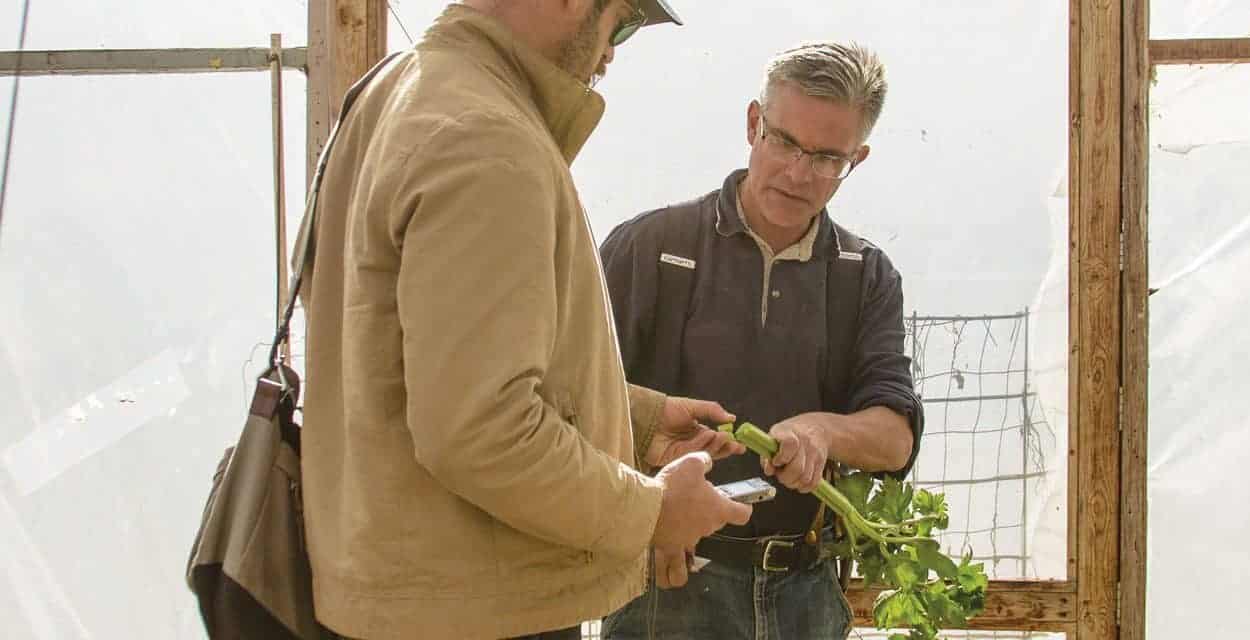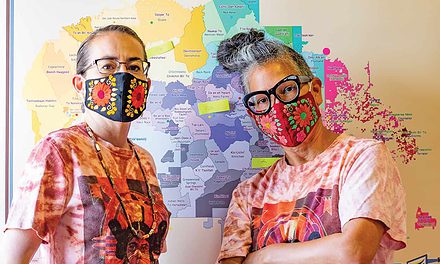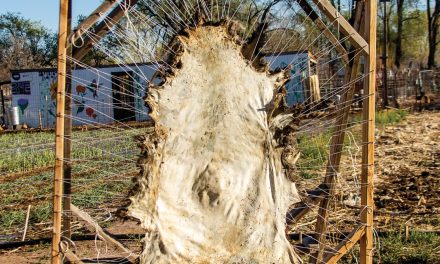By Michael J. Dax · Photos by Stephanie Cameron

Top left, clockwise: Michael Dax tastes Chris Altenbach’s hydroponically grown celery; the well-curated scrapyard waiting to be reimagined as farm tools; a steam-powered corn sheller (circa 1890s); and a compost sifter, constructed by Altenbach along with his father and son.
With Canada geese flying overhead, casting shadows across the brown fields of Albuquerque’s South Valley, Chris Altenbach, farmer and “farmacist” of Ironwood Farm, explains the philosophy that brought him back to his family’s ten-acre property after a twenty-year career as an aquaculturist and endangered fish biologist. “It’s almost an ethics question,” he says. “We want to be good to the earth every way we can, and one of the ways to do that is to reuse and repurpose materials.”
As a biologist, he worked to recover endangered species, but, as he describes it, conservation necessitates the herculean task of spending millions of dollars to fix problems that cost billions to create in the first place. While he still sees immense value in that work, he was ready for a change. With a desire to have an impact on a smaller scale and in a more controlled environment, he started practicing small-scale, regenerative agriculture in 2002.
For Altenbach, this means paying close attention to the biodiversity on his land. “The focus is in the soil,” he notes, adding that since he’s returned to the farm, he’s seen an increase in lizards, snakes, spiders, and insects—all of which indicate the health of the land is improving.
Altenbach considers with precision how all the pieces of his farm fit together. In his greenhouse, the water used to fill a tank of catfish is recycled through a hydroponic garden featuring strawberries and celery. Similarly, he placed an outdoor fish tank beneath a tree where his chickens often roost so that the waste from the chickens can feed the fish without his interfering. In the same vein, he designed the barnyard, where he keeps three cows, up to twenty sheep, and the occasional few pigs, so that he can move it every few years and ensure that the soil is able to recharge. To further improve the health of the land, after his chickens are slaughtered and plucked, Altenbach spreads the feathers over the fields. “It increases biodiversity because you’ve just added a different source of something some critter is going to utilize,” he explains.

Top right: Erin Hendrick pulls chickens from the plucker. Bottom right: Altenbach shows off his portable chicken-processing station, replete with a scalder, high-powered faucet, and what he describes as the “whizbang chicken plucker” (pictured top left).
Everything must serve a purpose. Although he sells eggs at local co-ops and to some restaurants, there’s not much profit in raising chickens.Their role on the farm is eating grubs and other insects and fertilizing the soil. The same is true of pigs, who will often eat wasted fruits or vegetables that can’t be used otherwise. “There’s no hauling of waste, there’s no moving of waste,” Altenbach emphasizes. “There’s no energy transport, no transfer of waste.”
In keeping with his desire to maintain a closed system, Altenbach has developed a knack for tinkering and building his own tools and equipment. Partly out of necessity and partly out of passion, Ironwood Farm is littered with machines and tools that Altenbach and his family have either built or restored—from large steam-powered engines to moveable tool kiosks that allow on-site tool storage.
Perhaps the best example of this resourcefulness is the compost sifter he designed and constructed along with his father and son. Drawing from a well-curated scrapyard in the back of the property, Altenbach repurposed materials including metal, wooden wheels from a nineteenth-century wagon, and an old engine to create a piece of niche farm equipment that no contemporary manufacturer makes. “We need equipment we can do mid-scale work with,” he says. “This equipment is important, and it’s gone.”
While small family farms used to be the dominant agricultural unit, large corporate farms have come to dominate the industry, and it has become increasingly difficult for people like Altenbach to find the equipment they need. When looking for a machine to shell sunflowers, the only option he could find cost twenty thousand dollars. Similarly, he couldn’t find the right-sized piece of equipment to shell corn, but thanks to his father’s penchant for collecting old farm equipment, they were able to restore a steam-powered corn sheller from the 1890s.
Borrowing the design from another farmer, Altenbach has also built a portable chicken-processing station, replete with a scalder, high-powered faucet, and what he describes as the “whizbang chicken plucker”—a rotating plastic barrel with three-inch rubber dowels drilled through that remove the feathers.
Both the chicken processing station and the compost sifter are mounted on wheels and can be hitched to a truck for easy transport, and he will loan both to other small farmers in the region. As a board member of the loosely organized Rio Grande Farmers Coalition, Altenbach helps facilitate the kind of information sharing that allows innovative ideas to spread. He hopes in the near future the group will be able to start a tool library that will allow small farmers to access more expensive equipment.
All of this, of course, ties back to Altenbach’s mantra of wanting to repurpose and reuse as much as possible. It’s an ethic that has largely faded from American culture, but with the rise of the local food movement and resurging interest in small-scale farming, there’s hope for a broader revival.
Edible celebrates New Mexico's food culture, season by season. We believe that knowing where our food comes from is a powerful thing. With our high-quality, aesthetically pleasing and informative publication, we inspire readers to support and celebrate the growers, producers, chefs, beverage and food artisans, and other food professionals in our community.












